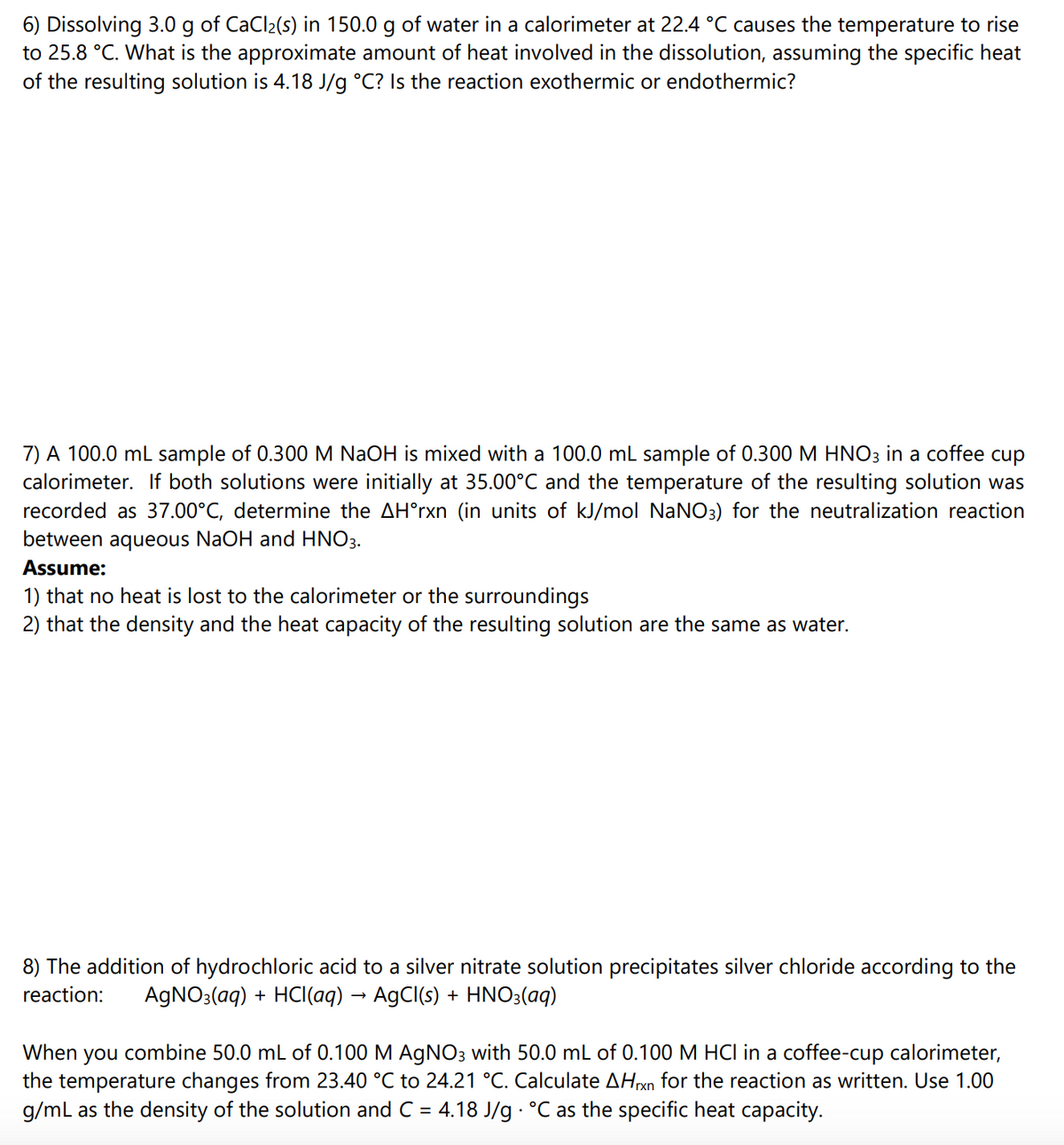6) Dissolving 3.0 g of CaCl2(s) in 150.0 g of water in a calorimeter at 22.4 °C causes the temperature to rise to 25.8 °C. What is the approximate amount of heat involved in the dissolution, assuming the specific heat of the resulting solution is 4.18 J/g °C? Is the reaction exothermic or endothermic?
6) Dissolving 3.0 g of CaCl2(s) in 150.0 g of water in a calorimeter at 22.4 °C causes the temperature to rise to 25.8 °C. What is the approximate amount of heat involved in the dissolution, assuming the specific heat of the resulting solution is 4.18 J/g °C? Is the reaction exothermic or endothermic?
General Chemistry - Standalone book (MindTap Course List)
11th Edition
ISBN:9781305580343
Author:Steven D. Gammon, Ebbing, Darrell Ebbing, Steven D., Darrell; Gammon, Darrell Ebbing; Steven D. Gammon, Darrell D.; Gammon, Ebbing; Steven D. Gammon; Darrell
Publisher:Steven D. Gammon, Ebbing, Darrell Ebbing, Steven D., Darrell; Gammon, Darrell Ebbing; Steven D. Gammon, Darrell D.; Gammon, Ebbing; Steven D. Gammon; Darrell
Chapter6: Thermochemisty
Section: Chapter Questions
Problem 6.109QP: A 21.3-mL sample of 0.977 M NaOH is mixed with 29.5 mL of 0.918 M HCl in a coffee-cup calorimeter...
Related questions
Question
I need help with all 3 questions.

Transcribed Image Text:6) Dissolving 3.0 g of CaCl2(s) in 150.0 g of water in a calorimeter at 22.4 °C causes the temperature to rise
to 25.8 °C. What is the approximate amount of heat involved in the dissolution, assuming the specific heat
of the resulting solution is 4.18 J/g °C? Is the reaction exothermic or endothermic?
7) A 100.0 mL sample of 0.300 M NaOH is mixed with a 100.0 mL sample of 0.300 M HNO3 in a coffee cup
calorimeter. If both solutions were initially at 35.00°C and the temperature of the resulting solution was
recorded as 37.00°C, determine the AH°rxn (in units of kJ/mol NaNO3) for the neutralization reaction
between aqueous NaOH and HNO3.
Assume:
1) that no heat is lost to the calorimeter or the surroundings
2) that the density and the heat capacity of the resulting solution are the same as water.
8) The addition of hydrochloric acid to a silver nitrate solution precipitates silver chloride according to the
reaction:
AGNO3(aq) + HCl(aq) → AgCl(s) + HNO3(aq)
you combine 50.0 mL of 0.100 M AGNO3 with 50.0 mL of 0.100 M HCI in a coffee-cup calorimeter,
the temperature changes from 23.40 °C to 24.21 °C. Calculate AHxn for the reaction as written. Use 1.00
g/mL as the density of the solution and C = 4.18 J/g °C as the specific heat capacity.
When
Expert Solution
This question has been solved!
Explore an expertly crafted, step-by-step solution for a thorough understanding of key concepts.
This is a popular solution!
Trending now
This is a popular solution!
Step by step
Solved in 3 steps with 12 images

Knowledge Booster
Learn more about
Need a deep-dive on the concept behind this application? Look no further. Learn more about this topic, chemistry and related others by exploring similar questions and additional content below.Recommended textbooks for you

General Chemistry - Standalone book (MindTap Cour…
Chemistry
ISBN:
9781305580343
Author:
Steven D. Gammon, Ebbing, Darrell Ebbing, Steven D., Darrell; Gammon, Darrell Ebbing; Steven D. Gammon, Darrell D.; Gammon, Ebbing; Steven D. Gammon; Darrell
Publisher:
Cengage Learning

Introductory Chemistry: A Foundation
Chemistry
ISBN:
9781337399425
Author:
Steven S. Zumdahl, Donald J. DeCoste
Publisher:
Cengage Learning

Chemistry: Principles and Practice
Chemistry
ISBN:
9780534420123
Author:
Daniel L. Reger, Scott R. Goode, David W. Ball, Edward Mercer
Publisher:
Cengage Learning

General Chemistry - Standalone book (MindTap Cour…
Chemistry
ISBN:
9781305580343
Author:
Steven D. Gammon, Ebbing, Darrell Ebbing, Steven D., Darrell; Gammon, Darrell Ebbing; Steven D. Gammon, Darrell D.; Gammon, Ebbing; Steven D. Gammon; Darrell
Publisher:
Cengage Learning

Introductory Chemistry: A Foundation
Chemistry
ISBN:
9781337399425
Author:
Steven S. Zumdahl, Donald J. DeCoste
Publisher:
Cengage Learning

Chemistry: Principles and Practice
Chemistry
ISBN:
9780534420123
Author:
Daniel L. Reger, Scott R. Goode, David W. Ball, Edward Mercer
Publisher:
Cengage Learning

Chemistry: Principles and Reactions
Chemistry
ISBN:
9781305079373
Author:
William L. Masterton, Cecile N. Hurley
Publisher:
Cengage Learning

Chemistry & Chemical Reactivity
Chemistry
ISBN:
9781337399074
Author:
John C. Kotz, Paul M. Treichel, John Townsend, David Treichel
Publisher:
Cengage Learning

Chemistry by OpenStax (2015-05-04)
Chemistry
ISBN:
9781938168390
Author:
Klaus Theopold, Richard H Langley, Paul Flowers, William R. Robinson, Mark Blaser
Publisher:
OpenStax